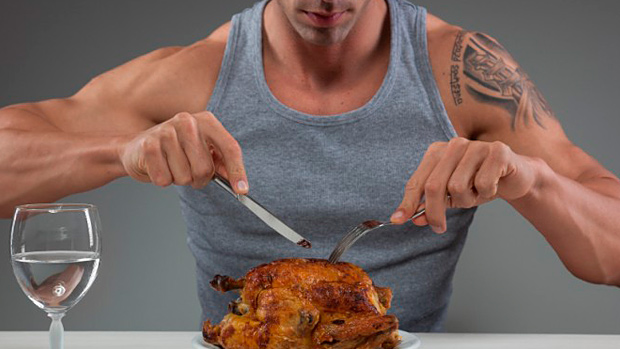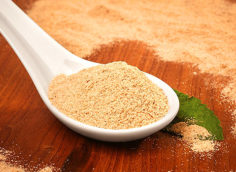Fat loss is a hot topic. Every month there are thousands of articles and dozens of new books telling people how to eat, how to exercise, and how to supplement to lose their flab. Now's my turn.
Part 1 of this article featured a discussion of four important concepts of fat loss, along with a short primer on fat metabolism and energy balance. Now that we've discussed all the theory, let's discuss how we apply that theory.
How Much, What and When To Eat
Understanding that energy restriction sometimes increases metabolic efficiency (this is bad for fat loss) and decreases both exercise and non-exercise energy expenditure (again, not good), it's important to find ways to get the metabolic rate back up again.
Certainly, increasing your exercise expenditure is one way. Another is to properly choose your energy intake, your food selections, and the times you eat. In doing so, you'll be better able to "uncouple" the energy intake and expenditure sides of the energy balance equation in order to improve your fat loss profile.
So how much do you need to eat? In order to determine this, you need to first figure out how much you're currently eating. The best way to do this is to record everything you eat (types of foods and weights/volumes of the foods) for three representative days of the week. For example, if your Mondays, Wednesdays, and Fridays have a specific schedule, your Tuesdays and Thursdays have a specific schedule, and your Saturdays and Sundays have a specific schedule, pick a Monday, Tuesday, and Saturday to record. (If all days are the same, just record any three days.)
Once you've recorded your intake, download the USDA's free calorie calculator program to figure out your total energy intake and macronutrient breakdown. You can download this program by clicking here. Once you know how much you're eating, it's important to calculate how far from your approximate energy needs you currently are. You can calculate those by clicking here.
Chances are there will be some discrepancy between the two. The calorie calculator suggested in the link above usually gives a number higher than most people are eating. In some cases, much higher. Whether this number is correct or not is impossible to determine. However, the number you'll get is derived from a study published in 1999 by A. DeLorenzo and colleagues at the University of Rome. These scientists directly measured the RMR of a group of 51 male athletes and determined that this equation predicted the RMR to within 59 kcal.
In addition to the men in the DeLorenzo study, this equation has also been validated in female athletes. In 1996, J. Thompson and colleagues at the University of North Carolina measured the RMR of 24 athletic men and 13 athletic women and determined that the equation was accurate to within 158 kcal for men and 103 kcal for women. These studies clearly show that this equation is accurate for use in athletic populations that exercise regularly.
Yet, any calorie estimation measure is just that – an estimation. So here's the best course of action: use my outcome-based decision model to try to get your calorie intake up to the level specified on the calculator, using of course, my food type and timing suggestions below. This should help you "reset" your metabolic rate, getting it to an all time maximum. Then you can start to slowly apply the old "eat less/exercise more" program.
Here's how to do it. Basically, you need to follow your plan for two week blocks and assess where you're at every 14 days. If the plan is producing a desired effect, keep it up. If the plan is producing a negative effect, you've gotta make a change.
 |
If fat loss is your goal and you're significantly under-eating, simply increase your energy intake by 250kcal/day for two weeks at a time until you get to your suggested energy intake. Then, once you get to this point, begin to scale back your intake by 250kcal/day for two weeks at a time.
Again, you'll be using the outcome based strategies above in order to measure whether your manipulation is taking you in the right direction or not. The beautiful part of this outcome based strategy is that you never have to abandon it. Simply adjust energy intake up or down based on the measurable changes you're recording.
So what about food type and timing? Well, both things are well-addressed in my 7 Habits article. In this article I lay out seven feeding strategies that, if followed consistently, produce the intersection of optimal health, body composition and exercise performance. Here's a review:
Habit #1: Eat every 2-3 hours (6-8 meals per day).
Habit #2: Eat complete protein with each meal (30-60 grams per meal).
Habit #3: Eat veggies (2-3 servings) and/or fruits (0-2 servings) with every meal.
Habit #4: Eat a mix of fats each day (~1/3 from sat., ~1/3 from mono., ~1/3 from poly.)
Habit #5: Eat non-fruit and veggie carbohydrate (liquid carbs and/or starchy carbs like pastas, rice, whole grain breads, oats, etc.) only within the first few hours after exercise.
Habit #6: Drink calorie-free beverages with or between each meal. Green tea and water should make up the majority of your fluid intake (excluding protein/nutrition shakes).
Habit #7: Eat whole foods for most meals (except workout and immediate post-workout drinks) unless impossible, then use supplements (shakes and bars) when necessary.
If you follow these seven suggestions, most of your food selection and nutrient timing needs will be taken care of. If you need an even simpler version, here's how I like to break down optimal nutrient timing:
• During and after the workout – Feed according to ADA (American Dietetics Association) guidelines with a little extra protein thrown in.
• For the first few hours after the workout – Feed according to the Zone principles (a balance intake of protein, fats and low GI carbs. I like fruit and veggie carbs at this time).
• For the rest of the day – Feed according to the Atkins principles (mostly protein and fat with some fibrous veggie carbs).
Now, just to clarify one thing: sometimes my approaches are criticized as too technical and complex. This assertion belies a fundamental misunderstanding of my system. Yes, I do demand some adherence to the scientific method. I won't apologize for that. Yet, at the same time, once you progress beyond the beginner stages of understanding, you'll see that a mastery of calorie calculations and macronutrient proportions and ratios takes no time at all.
Someone observing a beginner trying to follow my system – adding precisely 250kcal here, subtracting exactly 250kcal there – would think I've made the system too complex. However, someone observing an advanced participant in my system would think they're not even following it.
The reason? Outcome based measurement and decision making, meal planning and nutrient timing, once internalized, are easy to adhere to and can be calculated almost at the subconscious level once you understand the system. Eventually you'll easily be able to add a bit of food or subtract a bit based on how your body is changing. In some cases, all you'll need to do is look in the mirror to note these changes.
Here's another way to make it easy for you beginners: if you're a relative nutritional novice, don't even bother with the calorie calculations above. Seriously! Rather, simply begin following the seven habits. This shift alone will start you off in the right direction, kicking off your fat loss process in a big way.
However, if you've been dieting for a while now or have dieted several times in the past (successfully), you can start to break it down a bit more scientifically as above.
Essential Supplements For Fat Loss
Once the dietary guidelines above are met, I consider the next four supplements essential for fat loss.
1) Fish oil – Data from the University of Western Ontario shows that fish oil supplementation increases lean body mass (during non-dieting conditions), increases BMR (by up to 400kcal/day), decreases inflammation, and improves the ratio of fat/carb oxidized (sparing carbs, burning fat). Recommended dose: start with 6-10g per day of total fish oil (assuming 30% EPA and DHA).
2) Creatine – While creatine is usually considered a muscle building supplement, it does a good job of maintaining cellular energy status. This may help preserve/increase muscle mass. It also will preserve/increase exercise performance. Recommended dose: a few grams per day (3-5g) go a long way.
3) Recovery Nutrition – Supplements (or even whole food) containing carbohydrate and protein (such as Biotest Surge) and given during and/or after exercise can improve carbohydrate status (muscle glycogen storage), improve protein status (keep protein synthetic rates high), suppress cortisol concentrations, preserve immune function, and help preserve exercise performance.
Even if you don't ingest as much as you would during a mass phase, every little bit helps. Recommended dose: This is based on total calorie intake, however, a reasonable minimum is 0.4g/kg carbohydrate and 0.2g/kg protein during and/or after exercise.
4) Protein powder and greens powders – While I don't think these are necessary for every day nutrition, these two supplements are great in case of emergencies – especially when on the road. Normally my clients may only ingest one to two scoops per day of a protein supplement such as Low-Carb Grow along with one scoop of a greens powder.
However, when on the road, they may ingest up to six scoops of Low-Carb Grow! and two scoops of a greens powder. In addition to the convenience factor, micronutrient intake scales with total calorie intake. Therefore, if you decrease your intake during dieting conditions, greens supplements help maintain micronutrient status during energy restriction.
 |
Some of you may notice the conspicuous absence of fat burners. The main reason for excluding them from this discussion is the fact that I believe that they're most useful at the lower extremes of body fat, when intelligent diet and exercise are failing to produce a consistent loss of fat. At this time, the conservative and short-term use of something like Maximum Strength HOT-ROX and a green tea extract can help.
 |
It's Not About The FoodRemember, it's not necessarily the lack a good plan or the absence of some special physiological secret that keeps most people fat; it's failing to plan for the unplanned. Do you have a plan for when you wake up late or have to work late? Do you have a plan for unexpected obligations and deadlines; for unplanned dinner parties or lunch dates; for emergencies of any type? If you don't, that's probably why you're not as lean as you'd like to be!
Here are a few strategies that can help you ensure that good foods will be available when you need them:
1) The Sunday Ritual – The Sunday Ritual is performed by setting aside three hours or so every Sunday to write out your menu for the week, shop for the week, and prepare your meals for the week.
Cook all the meat, chop all the vegetables, measure out all the yogurt and/or cottage cheese, and distribute all the powders. Have them ready and set aside so that you can grab them in the morning and bring them with you regardless of what your day or your boss holds in store for you.
2) The Breakfast Ritual – Rather than preparing all their food for the week on a single day, some people prefer to do a little food preparation each day. That's what the Breakfast Ritual is for.
Using the Breakfast Ritual, simply perform all your cooking for the day each morning. Since you've gotta make breakfast anyway, make sure you've got a couple of meals going while breakfast is being prepared.
3) Have Others Cook For You – If you love the idea of having five or six readymade meals always available yet can't see yourself using the rituals above or buying all that Tupperware, there are a number of options at your disposal.
First, you can hire commercial food preparation services to do all the cooking for you. Or you could pick four restaurants in your immediate area (two fast food places, one medium-priced restaurant, and one higher priced restaurant) that prepare meals in a way that conforms to your nutritional plan and have them prepare the food for you when necessary.
Wrap Up
In the end, successful fat loss programs are based on having a good understanding of the body, making good physiological choices based on that understanding, and having the right systems in place to sustain those choices. Individual articles on specific supplements, specific diet plans, or specific workouts are interesting, no doubt, but integrate the three to truly optimize your body composition.
Note: A shout out to Dr. Lonnie Lowery for sharing the images in this article with me. He's a web illustration master and his "eye candy" is always appreciated!




